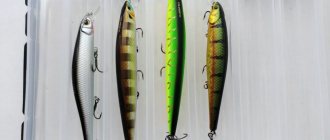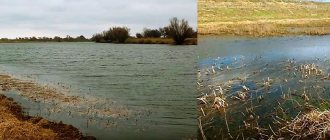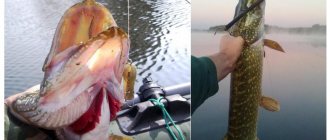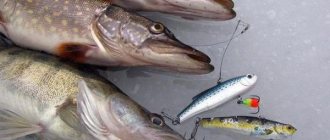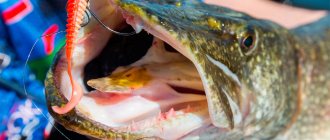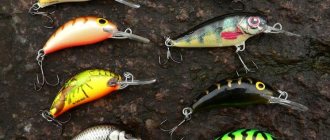With the arrival of spring, spinning pike fishing with minnow-class wobblers, which have proven themselves well at this time of year, becomes relevant. Soft, leisurely twitching of baits with a narrow, elongated body can provoke even a passive pike to attack, which after the winter easily succumbs to the call of predatory instincts.
Wiring wobblers in spring
In mid-spring, it is best to carry out soft, non-aggressive twitching with fairly long pauses, approximately 8-10 seconds. This method involves lightly twitching the bait using just the tip of the rod.
The appropriate amplitude of stretches and the optimal duration of pauses are determined experimentally. Some fishermen approach twitching so scrupulously and delicately that they write down detailed “melodies” of stretches and pauses in a notebook, which turned out to be the most effective in a given situation. You can only learn effective twitching through practice.
My wobblers for pike in spring
Fishing locations: the shores of the Boguchansky Reservoir. The depths are different. You can run into flooded shallow areas and a relief bottom, where a frequent drop of 5-6 meters will not be a curiosity. Coastal debris, flooded bushes and forest remaining under water after cutting down, unmelted ice, floating rubbish. This is what creates difficulty for the spinning angler and attracts the fish population. When assembling a set of baits, everything needs to be taken into account. Therefore, I will characterize wobblers by their diving depth and behavior during retrieval.
I repeat that in nature there is no distinction between wobblers (spinners and other lures) specifically for pike. It is completely normal if a perch or other predator living in your pond is caught as a trophy.
I mainly use minnows that have a positive degree of buoyancy. The main size is from 100 millimeters. I consider the predisposition of spring pike to small-sized baits to be reasonable only if we take into account reservoirs.
I prefer acidic color. And that’s only because it’s convenient for me to monitor the behavior of the bait. The objectivity of the statement that pike reacts better to one color or another is still being tested. I have data on various reservoirs where the predator prefers either a nondescript “minnow” color or an aggressive “acid” color. But I still don’t dare say 100% that the reason is the color. Most likely my approach in presenting the bait is wrong. Fishing is a constant learning experience .
If there is no “acid”, then there is nothing to worry about.
So. Which spring wobblers for pike will definitely end up in my travel boxes.
Wobblers with immersion depth from 0.5 to 1 meter
Salmo Skinner 10F
Shallow water bait. It twitches quite well, but I animate it with simple uniformity. It has its own game, which is enough to attract and provoke an attack. It floats up quite quickly, but this is not a hindrance.
Pontoon 21 Agarron 95 and 110 SF SR
Agarosha in size 95 is a wobbler that can be safely recommended to a beginner to get acquainted with this type of bait. It does not require a special rod, in principle, like its older brother. The only difference is in behavior. As expected, 110 has a tendency to be imposing.
You can lead with an aggressive twitch; on short jerks, the tip of the spinning rod goes slightly wider. Both versions float slowly even when using number 2 string as a leader.
Renegade Pike Death 115SP
I have only good things to say about this catchy budget wobbler. The catch includes perch and pike. For shallow water areas it is simply irreplaceable. It doesn't go deep. If visibility is good, I adjust the movement of the bait during the retrieve.
Pontoon 21 Zany Zag 100DW
Surface wob, designed for active fish. Despite the cold spring water, I recommend having it in a box and be sure to use it at shallow depths.
Wobblers with a dive of 1 to 2 meters
Tsuribito Dead Minnow 110 SP
Not a fast wob. With an imposing game compared to its smaller brother. This is what should be offered to spring pike.
TsuYoki Draga 130 F
Chinese replica of the Deps balisong 130. I took it out of curiosity. He showed himself quite well. Having picked up the leash, I achieve a slow ascent during a pause.
Evergreen Side Step SF
Wobbler for very lethargic pike and perch. If desired, it is carried out under the very surface. It reaches the specified depth of one and a half meters confidently. Twitch is not harsh with long pauses. With a leash it floats up very slowly. If a predator is interested, she will definitely take it. Not on the first, but on the second or third wiring.
Evergreen Mo-Do Custom Jerkbait Faith 115
A wobbler is a song if you pick up the key. Long cast. It quickly reaches the depth specified by the manufacturer of 2 meters. You need fast or at least medium-fast spinning. The wiring needs to be selected. When I got acquainted with this thread, I read that any animation is possible, even down to banal uniformity. In fact, it turned out that a series of weak end twitches with a pause, right up to the ascent, is the most optimal wiring. With this animation, the wobbler moves in a “herringbone” pattern, and when paused, it slowly ascends. If he drowns, experiment with a leash. I use 15 centimeters of fluor.
Jackall Mag Squad 115 and 128
For many anglers it has become a pike detector. With average depth, noise effect and ascent speed, it has one real characteristic - catchability. Last year, 2021, he became one of the pike leaders. Both sizes work, but I gravitate towards 128.
The model forgives any twitching. But I’m not a fan of the “pull out the fastening loop” technique, so a leisurely twitch with pauses. The number of jerks and the duration of pauses are selected according to location.
Open from spring to autumn.
Pontoon 21 Cablista 105F-SMR
Pontoon 21 Cablista above, below Jackson Katana
I once considered the version in size 90 to be optimal, but after purchasing 105 and, a little later, 125, I realized that I was too hasty in my judgment. A very successful model.
The game is wide and sweeping. When surfacing, it swings its sides. Pike like it. Yes, me too.
Lucky Craft Slender Pointer MR 112 and 127
Test wobblers have every right to be in the permanent composition of the pike catcher.
Catching models of wobblers
Our own experience and advice from fishermen indicate that pike after spawning bite remarkably well on Yo-Zuri L-Minnow 44, ZipBaits Orbit 65 Slider SP and other similar wobblers with a length of up to 7-9 cm and a diving depth of up to 1-2 m.
There are a lot of positive reviews and descriptions of dozens of spring minnows for pike floating around the Internet, so choosing a catchy bait and not going wrong is not so easy. However, from all the variety, we can single out those wobblers that have been in use for a long time, have been in stable demand for years and are at the same time available in most specialized stores.
- Rapala: Husky Jerk (6 cm);
- X-Rap Shad Shallow (6 cm);
- Yo-Zuri Hardcore Shad (6 cm);
- Jackall Squad Minnow (6.5 cm);
- Yo-Zuri Hardcore LB (7 cm);
- Jackall: Tiny Magallon (8.8 cm);
- Yo-Zuri: Crystal Minnow (9 cm);
Good to know for the spinning angler: the best pike lures
Top spring wobblers for pike fishing 2021
Spring pike fishing can start in different ways.
It all depends on when the first thaws begin and the snow begins to appear. The ice moves away from the shores, leaving narrow strips of clean water, in which it becomes possible to catch the first pike using summer fishing methods. Sometimes the first spinning fish appear at the beginning of March, or even at the end of February. The water temperature at the beginning of spring does not exceed one to three degrees, and therefore any fish at this time is still very lethargic and does not behave actively. Pike is no exception. Only after daylight hours become longer, the atmospheric pressure becomes more stable, and the water temperature reaches five degrees. Then the pike becomes active and fishing becomes more interesting.
In early spring, this predator approaches the banks of rivers to feast on small fish, and this is where it should be caught, in relatively warm shallow water. At this time there is not yet a large amount of algae and the bottom of the reservoir is quite clearly visible. Therefore, in some places you can even watch how pike hunts.
For spring fishing, it is best to use small spinners of yellow or white shades. Just in case, it is necessary to have several types of bait, since the weather changes dramatically in the spring and the fish reacts to some types of bait in the daytime, and to completely different ones in the late afternoon.
Pike fishing becomes most interesting towards the end of April, when the ice no longer interferes with anglers and the water becomes even warmer. At this time, the pike begins its most active feeding phase. It is then that you can catch it with absolutely any bait. Experienced anglers never miss this best time to catch pike.
Well, now I offer a spring top wobbler for pike.
The best wobblers for spring fishing in 2021:
- Zip Baits Khamsin 70 SP
- Sert Killer Pop
- Jackall Squad Minnow 80 SP
- Jackall Tiny Magallon
- Lucky Craft Pointer 100 Sp
Zip Baits Khamsin 70 SP took first place this year . The discounted price fluctuates around 1100 rubles. I wrote about it in detail here. Let me remind you that the working depth of this bait is from one to 1.5 meters. With a length of 7 cm, it weighs 9.5 grams. It is a Shad suspender. Made of durable plastic that is practically resistant to sharp pike teeth. Equipped with a special loading system, which allows, with the proper skill, long-distance and accurate casting. High-quality fittings, sharpest hooks, a rich range of colors from more than 30 colors - it’s all about him.
It does not make any special demands on the gear, it is absolutely not stubborn and easily performs the given animation. For wiring I mainly use classic twitch or stop-n-go, but the latter brings more effective results.
The main fishing grounds are various standing reservoirs, but even in fast currents it remains a very effective bait that does not lose an ounce of working qualities. The Khamsin 70 SP was successfully used this year already at the beginning of April and is still catching to this day. In addition to pike, he successfully collects chubs, perches and asps from the nearby area.
Sert Killer Pop came in second place this year . The discounted price fluctuates around 600 rubles. I already had the older 100-mm model, which was excellent at mowing down pike in August, but I just bought the younger one from one of the online stores in colors O, FTG and J07 just last winter.
So, a short flood and a rapid descent of water made their own adjustments to fishing. Usually my fishing with poppers traditionally begins towards the end of June, but one of the first open water fishing trips this year brought an unexpected result. On one of the sections of our river near the shore, last year’s water has practically become exposed. There were no special wobblers for these conditions, or they were more suitable for summer fishing, so the desire arose to use the 8-centimeter Sert Killer Pop. With a special aerodynamic shape and a weight of 12 grams, I was simply stunned by its flight characteristics. The popper easily flies over 50 meters. In general, the first cast, a line to the shore and a powerful throw of the pike. A short struggle and a 4-kilogram pike on the shore. On this and subsequent days, more than 4 dozen pike were caught.
The coating is of very high quality, but after such use for a month you can see the consequences in the photo. Although this did not affect the quality of fishing at all. The hooks are very sharp and when removed from the reeds, the pike's mouths did not lose their sharpness and did not straighten up. I tried to exchange them for the same size, but unfortunately the popper became sinking, so I returned it back.
After casting, the wobbler goes a little deeper, so I wait 4-5 seconds and start jerking, as a result of which the Sert Killer emits a very expressive and loud “smack”, which so furiously provokes the predator to attack. If there is subsurface grass, I start wiring immediately after the fall, since it will definitely grab this grass when it goes deeper. Both asp and large perch do not miss this wonderful popper. So I advise and answer for my words with 100% confidence
In third place in my top is
Jackall Squad Minnow 80 SP . The discounted price fluctuates around 1000 rubles. The classic minnow suspender weighs 9.6 grams with a length of 82 mm and operates at a depth of 0.8 to 1.2 meters. The splashdown field quickly descends to the declared depth and then operates within this horizon. The body of the bait is made of durable plastic, perfectly balanced and has a noise chamber that attracts predators from various depths. Equipped with two sharpest tees. The color scheme is presented in more than 20 colors, from bright aggressive to natural. Most effective when performing various twitching wiring. In general, I consider it the best twitching wobbler, which any novice spinning player can skillfully animate. You just need to choose the appropriate rod and reel set.
Squad Minnow 80 SP successfully catches pike, pike perch, perch, etc. You just need to change the 8-centimeter model for two from this series: 65 or 95 mm.
In fourth place is baby Jackall Tiny Magallon . It showed itself most successfully in the second half of spring. Although it will catch until late autumn. The discounted price fluctuates around 1300 rubles. It is a two-part suspender minnow, which has its own game, expressed by uniform vibrations even without the presence of a current.
With a length of 88 mm. weighs 7.2 grams. The tail part has a silicone tail. The color range is varied, but I bought the older and younger models in matt tiger color. In general, this is my favorite color at different times of the year. Thanks to its excellent balancing and loading system, the wobbler exhibits excellent flight qualities for its size.
The fittings and hooks are very reliable, although it is better to remove the winding ring, since overlaps are common when casting. The best qualities are revealed when performing a jerk retrieve, reaching more than 15 seconds with a passive predator. But even with uniform driving with stops, it absolutely does not lose its working qualities, and has a clearly defined game of its own. Usually this is 3-4 turns of the coil and a few second pause.
It is most advisable to use Jackall Tiny Magallon in shallow water and thickets of water lilies.
Lucky Craft Pointer 100 Sp - closes the top five best spring wobblers for pike
An excellent wobbler for spring pike fishing. With a length of 10 cm, it weighs 18 grams. A huge number of colors - 67 pieces. It has neutral buoyancy and is capable of operating at a depth of one to one and a half meters. Has excellent flight qualities. Thanks to the low center of gravity and a special loading system, it can cause low-frequency damped oscillations during a pause and retrieve, which provokes even an extremely passive predator to attack.
The wiring is clear even to inexperienced spinning anglers - a light classic twitch (2-3 jerks and a pause) , during which it scours around in an interesting way.
Wobbler type and size
In the spring, immediately after the ice melts, pike go to shallow water areas to spawn. Having spawned, the predator waits in the same areas for a peaceful fish, which, in turn, is also going to spawn. Therefore, for spring pike fishing you need to choose something shallow. The best option is minnow type wobblers. These are elongated baits that do not go very deep. Such wobblers imitate live fry, which is a favorite treat for pike in the spring season.
Small wobblers are more effective. If pike fishing occurs before spawning, then the predator’s stomach is crushed by the eggs located in the belly. There is simply no room for large bait in it. After spawning, small and medium wobblers should also be used. Up to 8 cm. The predator most likely cannot cope with large prey, having become exhausted during spawning.
Fishing rod
To catch these reckless and fast-moving predators, you need a light twitching rod made of carbon fiber with a fast action. But at the same time, the rod must have sufficient sensitivity. Its length should not exceed two and a half meters. Typically these are lightweight rods that have a spaced handle and have test indicators within 5-25.
To equip the fishing rod, a small spinning reel is used, on the spool of which a braided cord is wound. In conditions of rapid spring currents, a cord is preferable, since the fishing line is not able to resist the pressure of water and stretches. Although many people like fishing line better. Apparently, the fact is that the conditions are not the same everywhere, and the force of habit is great if you get used to fishing with a fishing line.
Fishing from a boat
Upon arrival at the reservoir, you need to pump up the boat. Many fishermen use the classic “frog”, which wastes a lot of time and effort. Modern electric pumps are compact and have high pumping speed. There is no need to inflate the cylinders completely; this is done using a hand pump.
Fishing together is much more convenient than fishing alone. This is due to both movement and fishing. Sometimes it is problematic to get a large pike, because you need to manage the spinning rod, oars and catch yourself. The help of a friend in these cases is most welcome. If the boat is equipped with a motor, then first you need to warm it up by letting it run in idle gears.
Fishermen take two rods with them. During one fishing trip it is rarely possible to switch between different fishing methods, so the main “stick” is a spinning rod for wobblers, and the additional one is a lighter fishing rod with which you can catch chub and perch . The rod test depends on the baits used, but, as a rule, its upper limit rarely exceeds 45 grams. For fishing with wobblers, use spinning rods of medium action, since the baits have an amplitude action, which is displayed on the whip of the blank.
The rafting starts from a place with good entry into the water. On small rivers the boat is led in the middle, making perpendicular casts in different directions. Thus, two anglers distribute between themselves two banks, towards which the baits fly. On a small river you don’t need a motor; ordinary oars are enough, but fishing on large bodies of water requires not only this device, but also an echo sounder.
It is difficult to find pike in an unfamiliar body of water, so you need to be guided by the main signs of the presence of a predator:
1. Shelters. It should be remembered that the pike attacks from an ambush. Snags, thickets of grass and water lilies, and various structures serve as places for shelter. On small rivers you can see them firsthand. One precise cast brings a bite and capture of a spotted beauty.
2. Clusters of fry. The predator always stays close to its prey. From a boat, the fry can be seen better than from the shore, and this advantage must be used to the maximum. Also in such places you can find perch, chub and asp, which will be an excellent “bonus” in the catch.
3. Splashes. Active fish reveal themselves on the surface. If a fry was seen jumping out of the water in different directions, then this fact indicates the meal of a predator. The main thing is not to swim close to the feeding place, because you can scare the cautious inhabitants of the ichthyofauna.
4. Depth and current. In spring, pike come out to shallow water in search of food. Before spawning, she finally leaves the holes and depressions, going to spawn in quiet backwaters. There are exceptions to every rule, but large concentrations of predators often end up at a depth of up to two meters. The toothy beauty will not be on the stream, but under the edge of the reeds she often ambushes. The ideal parking place has snags and calm water, which borders on a current that brings food in the form of roach or silver bream that has lagged behind the flock.
Having put all the factors together, you can safely go after the toothy beauty, devoting more time to promising areas. Sometimes the fish does not take on the first cast, so it is necessary to place the bait with less scattering. The first retrieve can only interest the predator, and on the second it will come out of ambush and rush to the wobbler.
A little about pike fishing
Using pike wobblers involves mastering a huge number of special wiring. The simplest animation consists of the monotonous movement of a wobbler in the working area. Small pauses add attractiveness to such a game; as a rule, the predator attacks the bait precisely at a stop.
Each wobbler has special characteristics. All baits are divided into three types: floating, sinking and suspender. For fishing from a boat, use any artificial bait, but suspenders are preferable . They show themselves before the spawning of pike, when the fish are not yet so active. Neutral buoyancy allows the product to hover within sight of the pike. Slight swaying of the wobbler's body lures a predator, who can approach the bait in the first seconds and then decide to attack.
In sections of the river with shallow depths, twitching wobblers with an elongated shape work great for pike . Jerk wiring provokes an active pike much more effectively than monotonous animation. Twitch can be single, double and triple. In each specific situation, a certain way of playing works, which must be selected directly in practical conditions. Read more about twitching for pike.
Wobbler colors
There is an opinion that for pike the color of the bait is not a determining factor. The main thing is that the wobbler is visible. However, when choosing the color of the bait in the spring, you should take into account the specifics of the reservoir (presence of aquatic vegetation, water transparency) and weather conditions. Thus, golden-colored wobblers are preferable on a rainy or cloudy day, while golden baits are more effective on a sunny day. It is necessary to start fishing with natural neutral colors, and if there are no bites, move on to provoking colors.
Technique for wiring sinking wobblers
Sinking wobblers for catching pike in the spring perform well in reservoirs with a pronounced current. They start playing as soon as they dive into the water. The behavior of the pike may depend on the speed of the retrieve. If the retrieval is quite slow, the predator can pursue the intended prey to the very bottom and begin to attack the moment the wobbler falls. A quick retrieve can provoke the pike into an instant bite. The game can be even, stepped or with effective jerks. This bait can be used for fishing even at the very bottom.
Choose wobblers based on our advice and go fishing. Happy biting!
